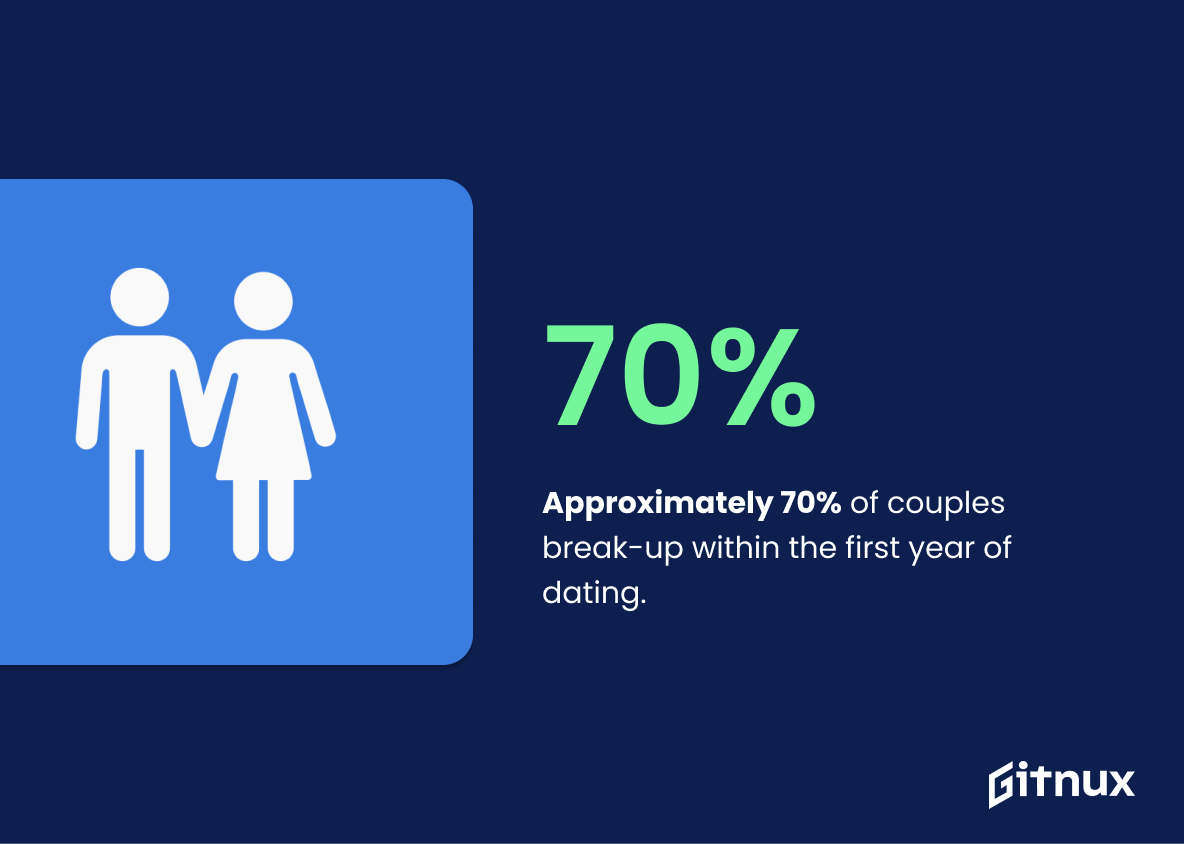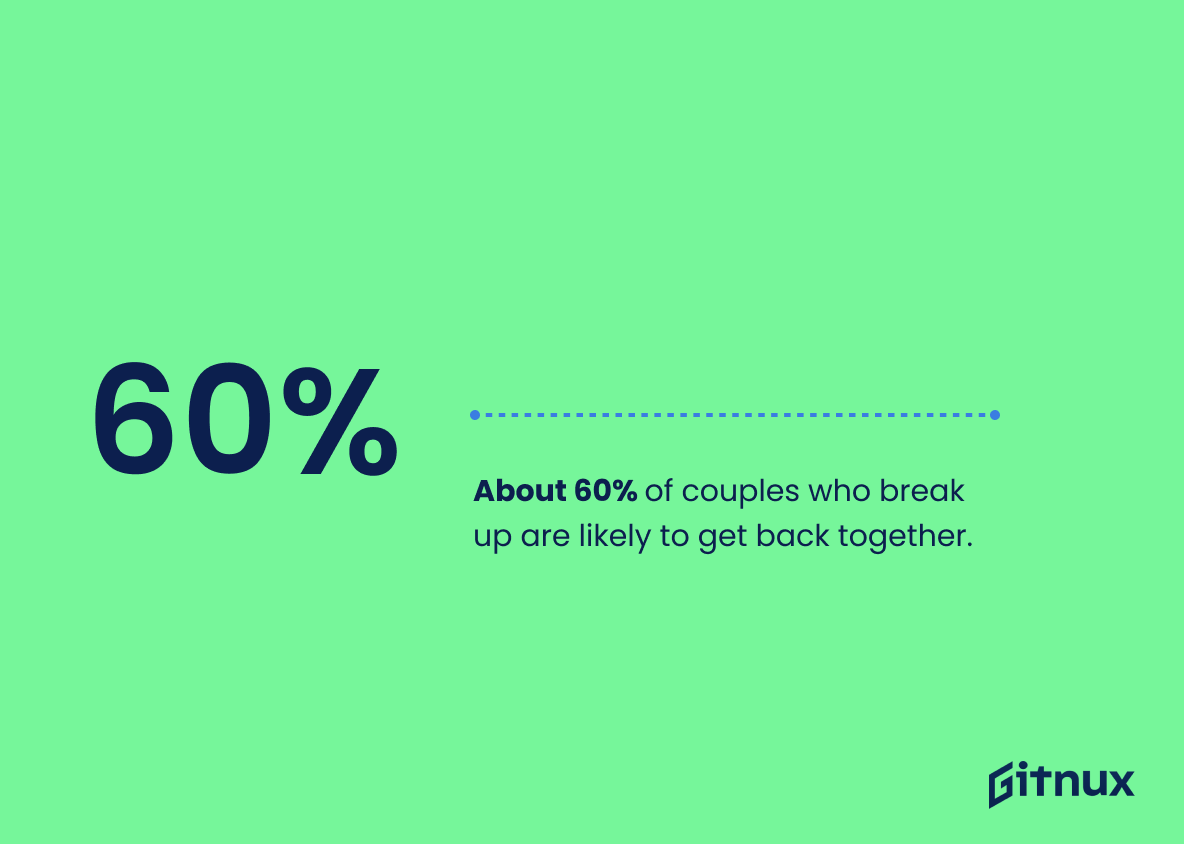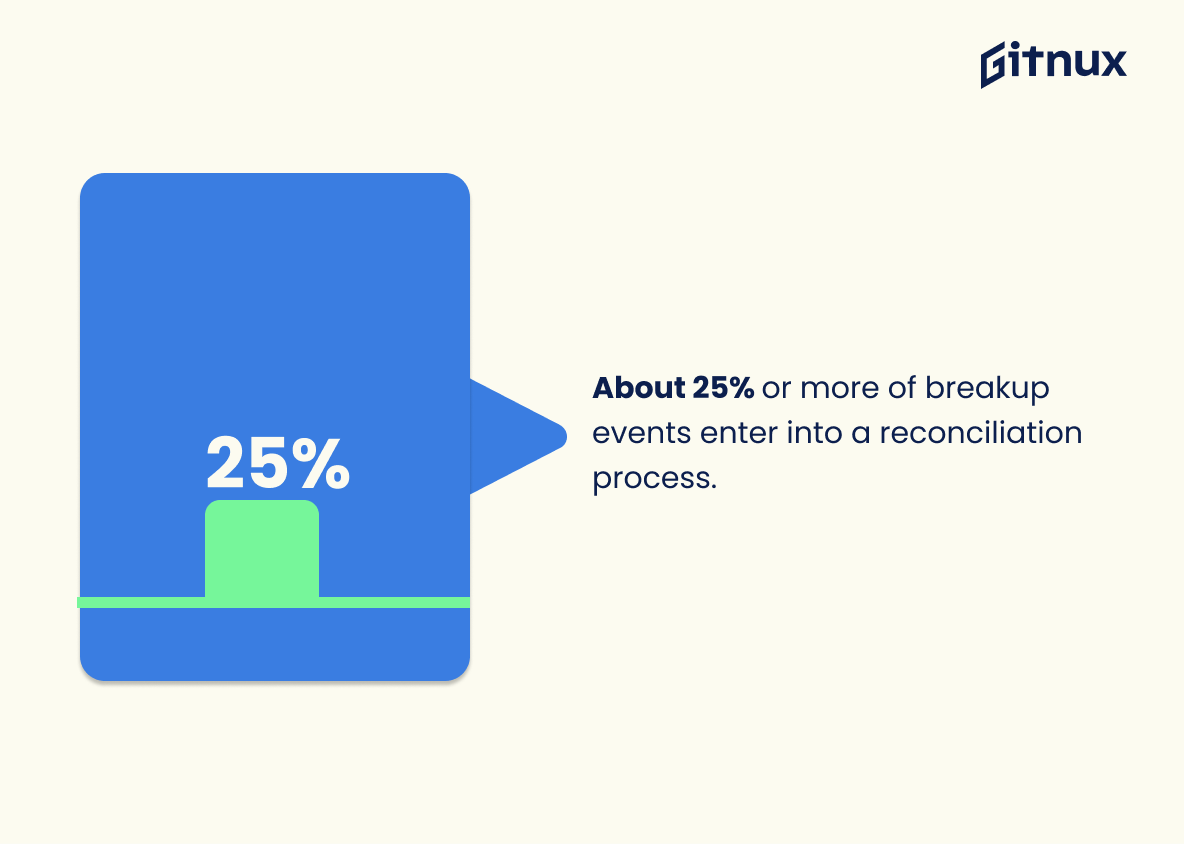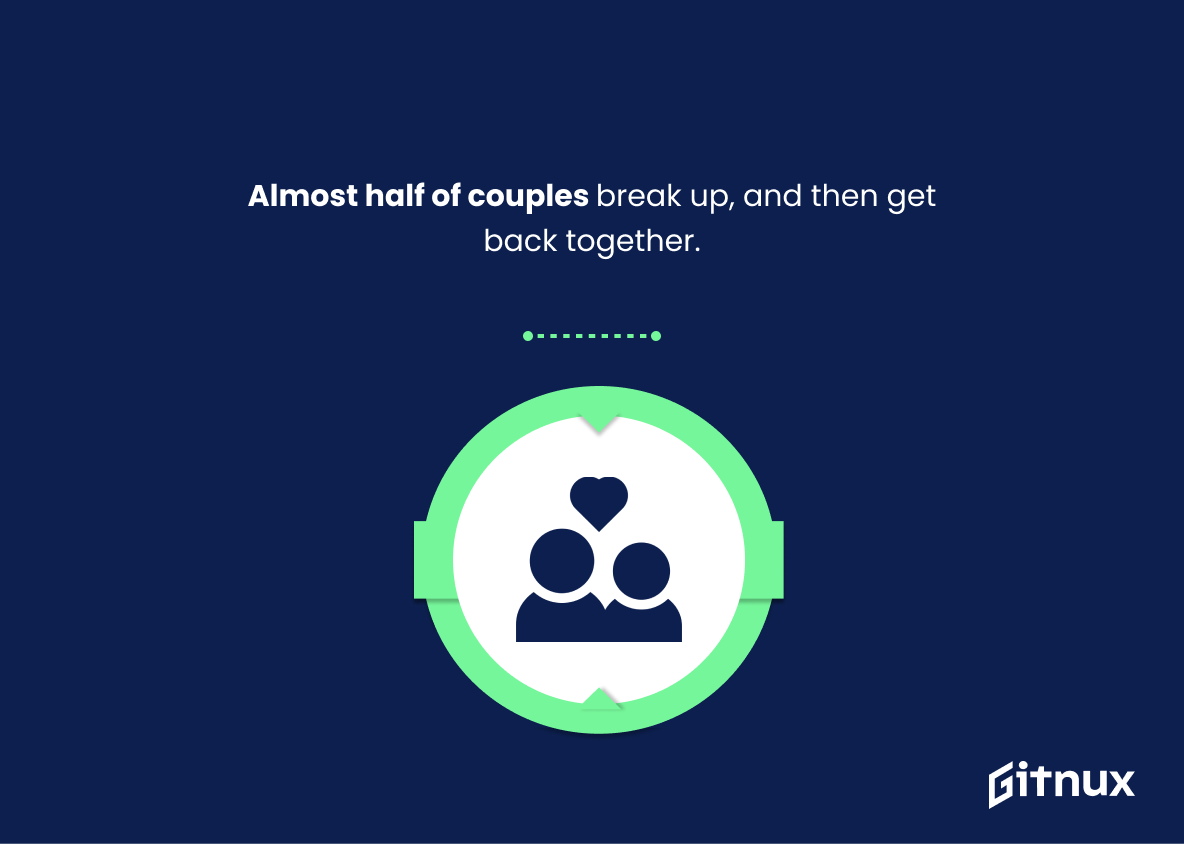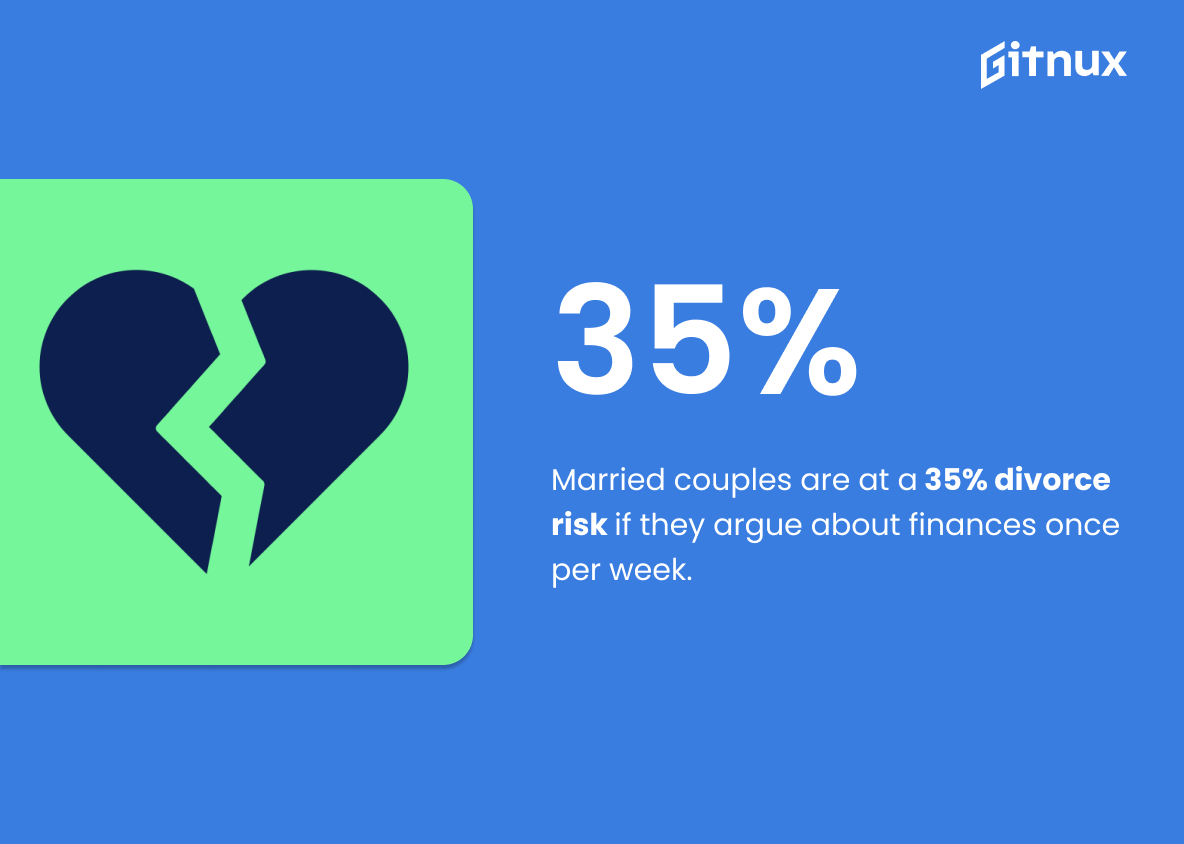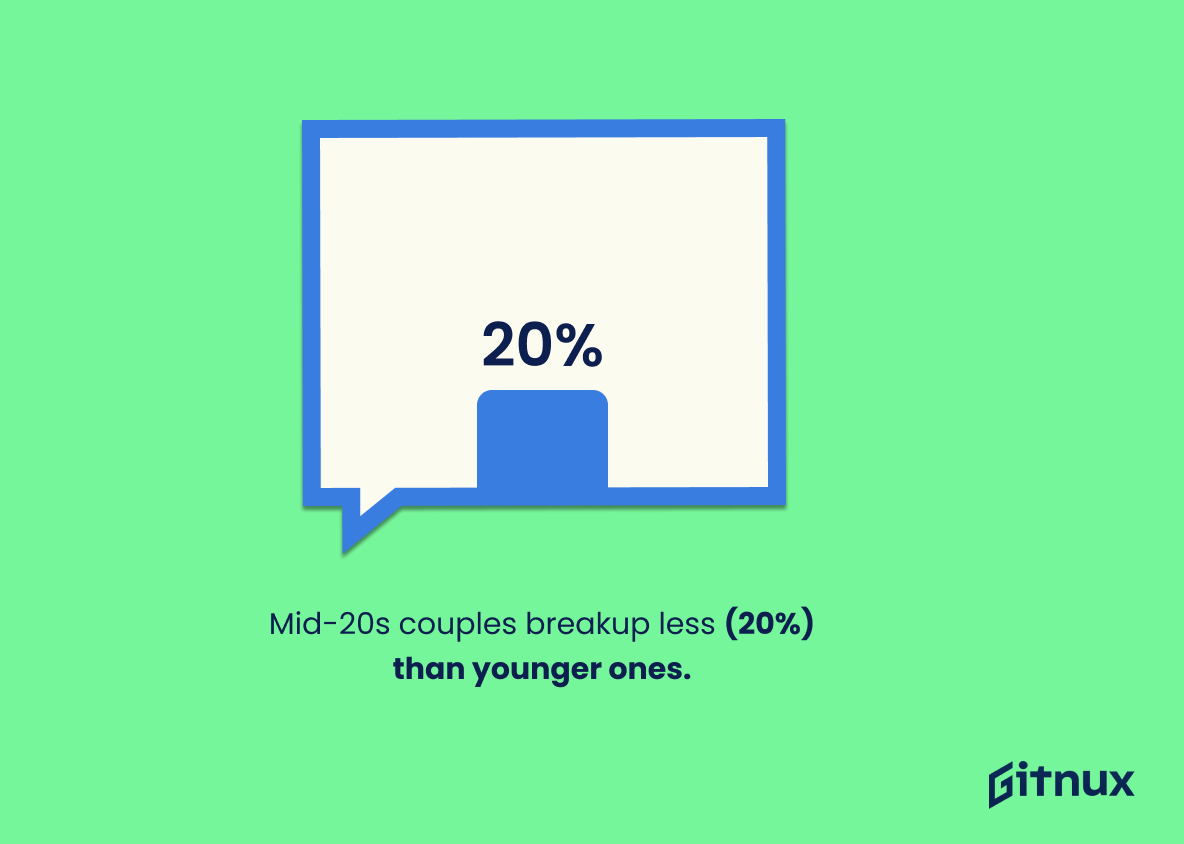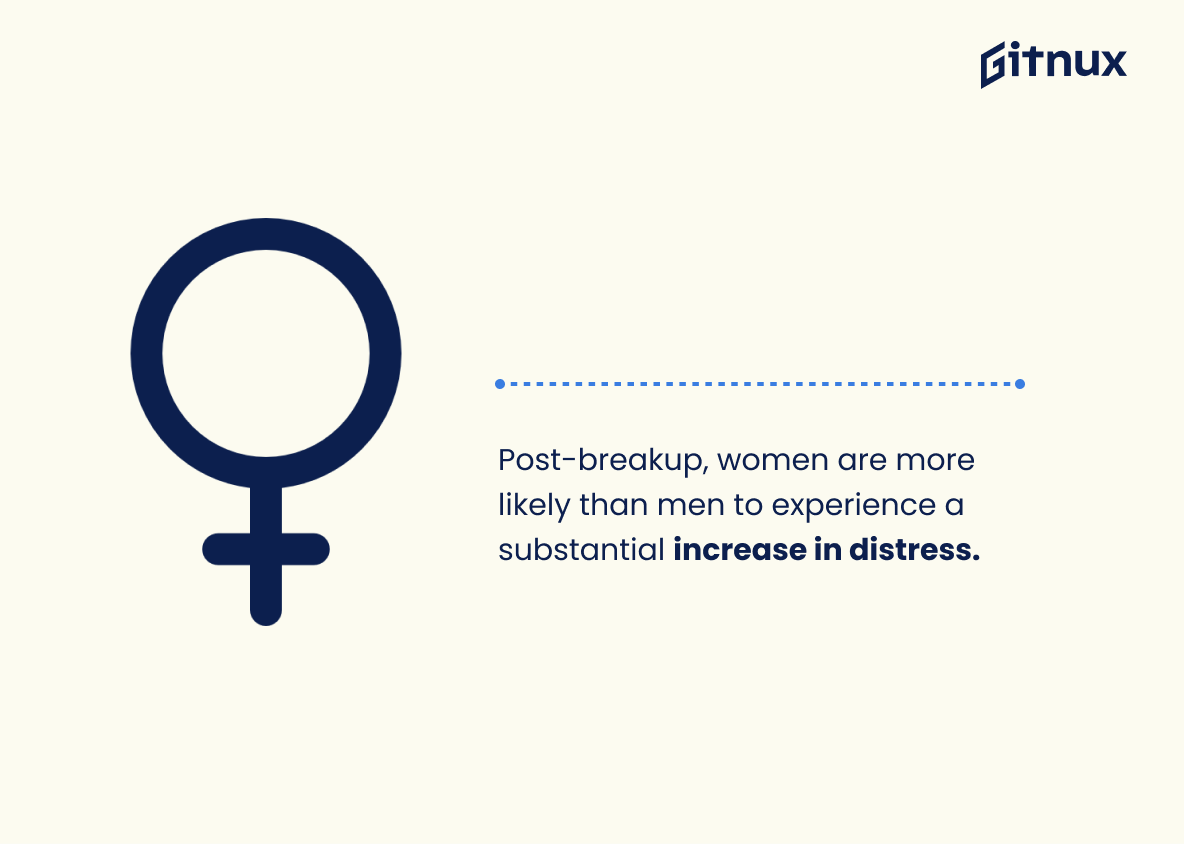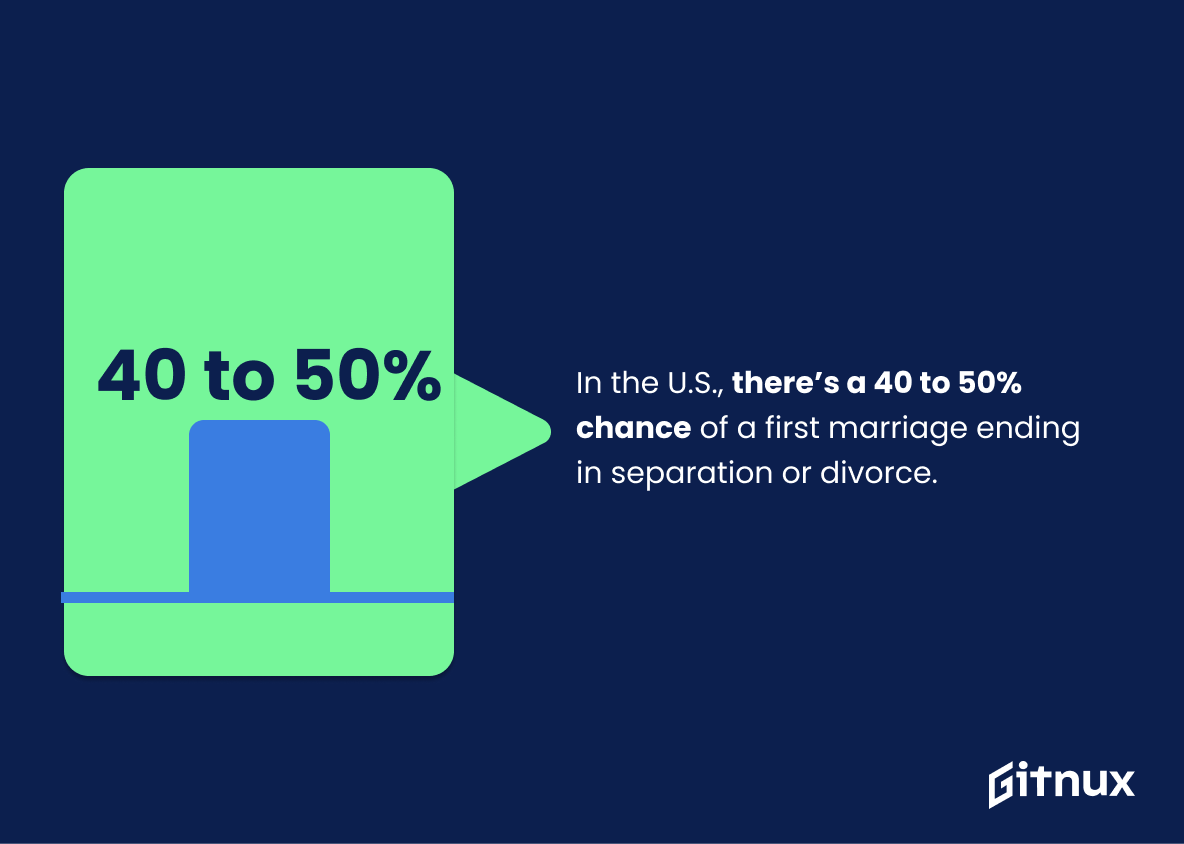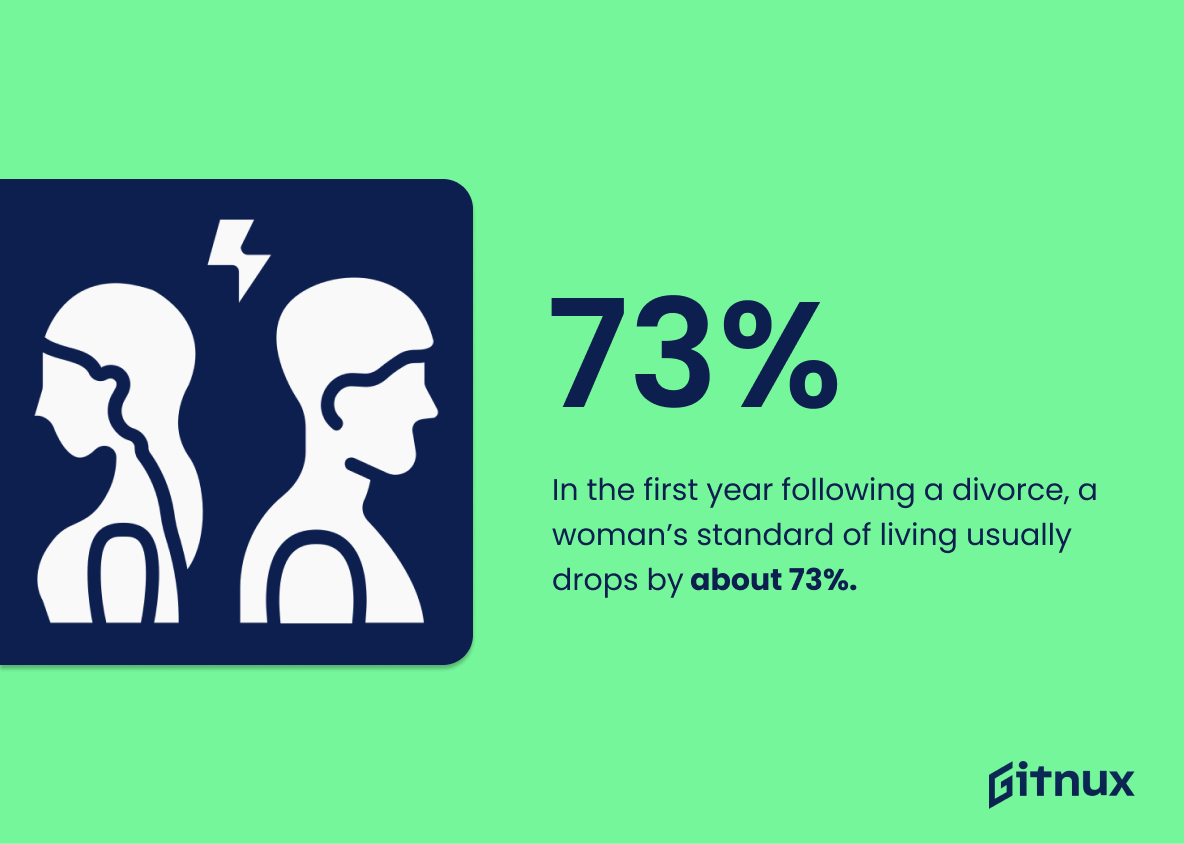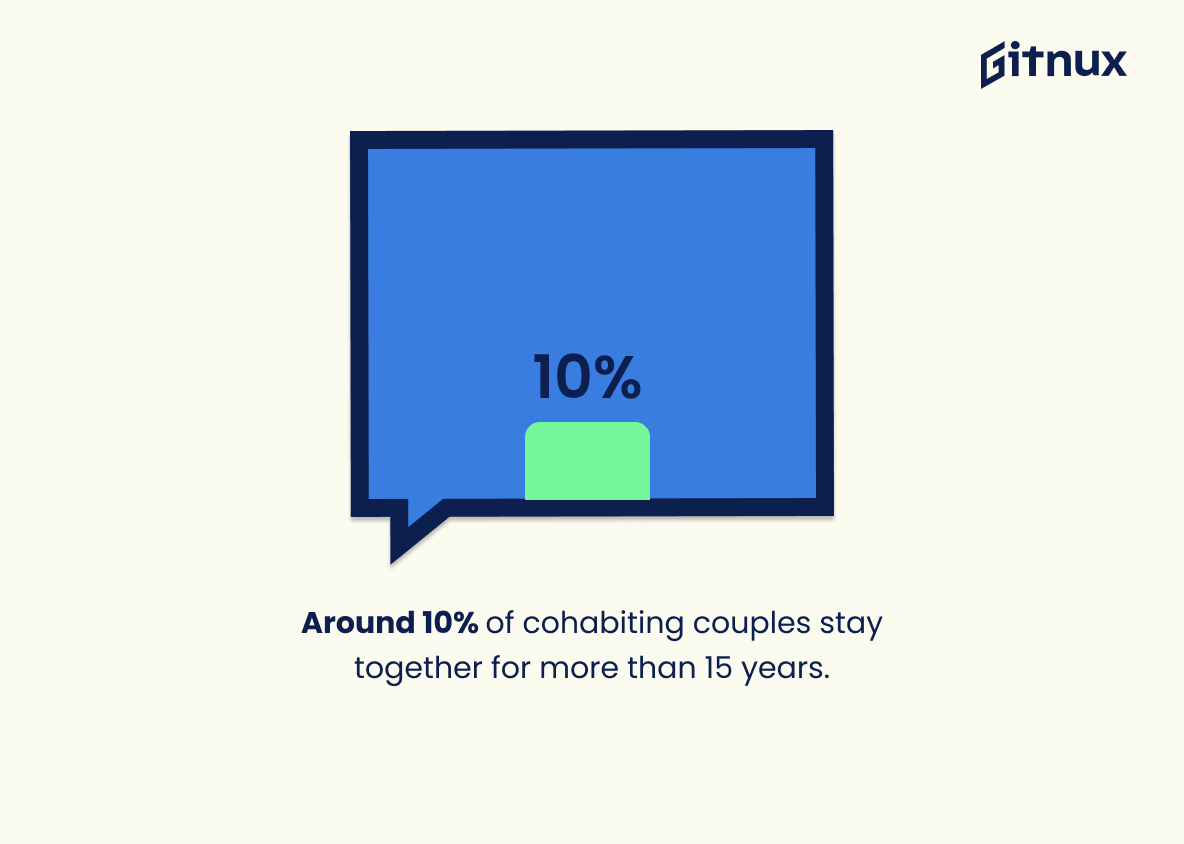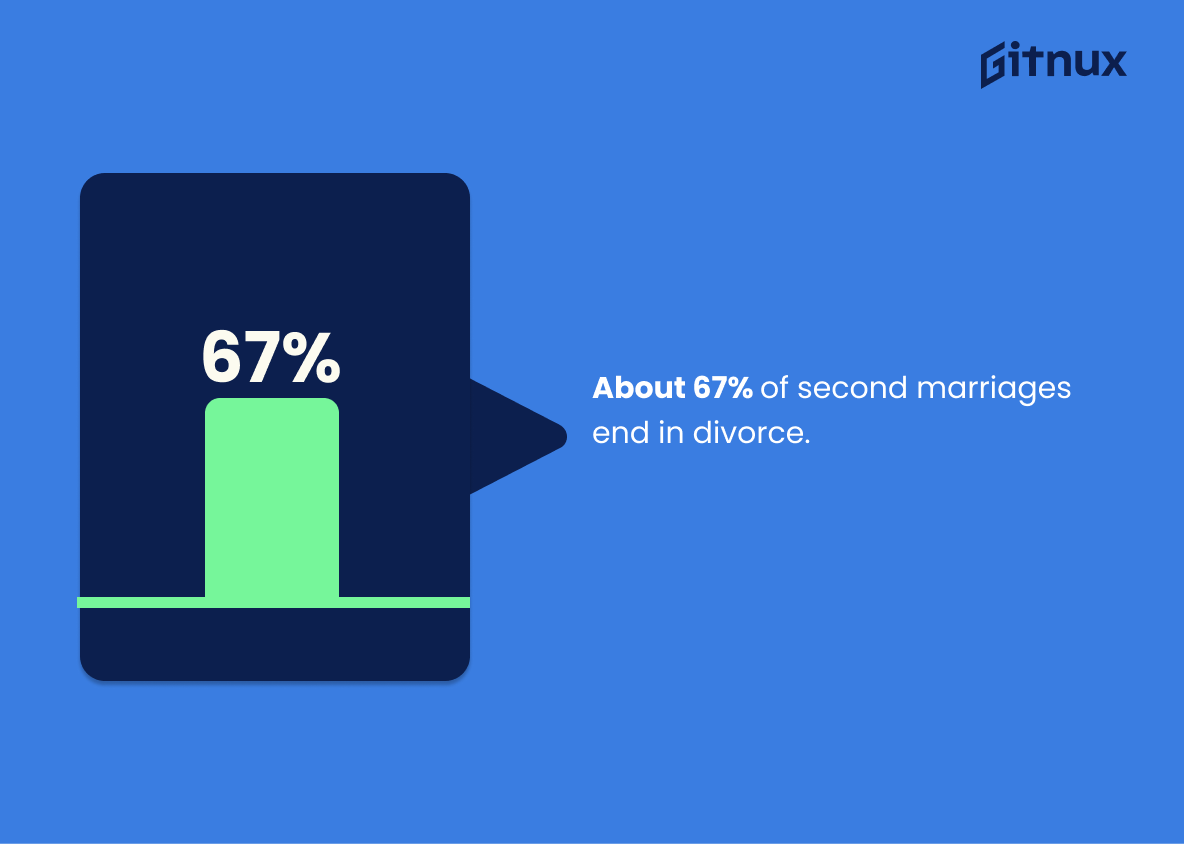We’ve all been victims of cupid’s mischievous arrows at some point in our lives. Sometimes, they lead to stories of undying love, and other times, not so fortunate breakups. But have you ever paused and pondered the journeys of other hearts? What percentages of relationships face the harsh winds of separation?
Welcome to our comprehensive blog post, where we delve deep into the intriguing world of couple breakup statistics. Over the course of this article, we’ll shed light on some surprising figures, trend patterns, and contributing factors that shape the narrative of modern-day romantic relationship dissolutions.
The Latest Couple Break Up Statistics Unveiled
Approximately 70% of couples break-up within the first year of dating.
In the diverse realm of couple break-up statistics, the statement that around 70% of couples part ways within the first year of dating paints a startling picture. It brandishes a magnifying glass over the fragility of beginning relationships, with the one-year mark emerging as a critical threshold. Anyone setting sail on the ship of love would benefit immensely from understanding these statistics. In our blog post, we’ve used this information to not just set the stage for a deeper dive into the world of breakups, but also to guide couples towards comprehending potential pitfalls of early dating, and navigating these perilous waters successfully. These figures also provide valuable insight for experts trying to assist couples in strengthening their relationships and for researchers untangling the complexities of human romantic relationships.
After living together for two years, there’s a 50% chance that a couple will break up or get married.
Navigating the tumultuous seas of romantic relationships often leaves one yearning for a compass, a guideline, something that might hint at what lies in the future. It’s here that the statistic “After living together for two years, there’s a 50% chance that a couple will break up or get married” lights up like a beacon in the dark. In unraveling the intricate tapestry of couple break up statistics, this particular thread stands out in bold relief. It offers not only a timeline but also odds that play out as either a splitting fork in the road or the merging of paths. It accentuates the unpredictability of relationships, harnessing percentages to highlight cohabitation’s stark realities. It paints a vivid picture of the watershed moment after two years, underscoring the precipice of commitment or separation that couples may find themselves standing on. This statistic, deep-dive into the world of relationship dynamics, serves as an eye-opener for readers about the concluding uncertainty that cohabitation often brings with it.
About 60% of couples who break up are likely to get back together.
Delving into the world of romantic relationships, understanding the dynamics that come after a break up is as crucial as knowing what causes the rupture. The statement, “About 60% of couples who break up are likely to get back together,” illuminates this somewhat murky post-separation landscape. This revelation breathes a fresh perspective on break-ups, reframing them not as the end of the road, but potentially, the preamble to reconciliation.
In the realm of Couple Break Up Statistics, this insight forms a cornerstone. It hammers home the point about the fluidity of relationships, the commonality of couples reviving their partnerships, and the optimistic view towards break-ups. It also stimulates discussions about the reasons behind this high percentage of reunions. Perhaps it paves the way for improved communication, fosters emotional growth, or facilitates a deeper understanding between partners.
In sum, this statistic masterfully weaves an unexpected strand into the complex tapestry of romantic bonds, urging readers to reassess the finality often associated with ‘break-up’ and to acknowledge the high reconciliation possibilities. This narrative shift makes it a critical piece of any comprehensive discussion around Couple Break Up Statistics.
About 25% or more of breakup events enter into a reconciliation process.
Shine the spotlight on an engaging spin-off from our romantic narratives – imagine, one in every four breakups might not be hitting the final curtain call. Instead, they’re engaging in a potential make-up process. In the landscape of couple break up stories, this staggering 25% spins an optimistic tale of potential second chances and narratives of reconciliations. This holds a mirror up not just to the dynamics of breakups, but also the psychology of love and relationships. It’s more than just numbers – it’s about patterns of human behavior, the malleability of love, and the intimate chaos of coupledom.
Almost half of couples break up, and then get back together.
Immersing ourselves in the fascinating world of couple dynamics, this intriguing statistic paints a riveting storyline. Highlighting the elasticity of romantic relationships, it lays bare an astonishing reality – breakups are not necessarily the end, but perhaps a hiatus or turning point. In the light of couples parting ways and then finding a path back to one another, we’re treating a prevailing dichotomy in the relationship discourse. Thus, it not only adds depth to the analysis but invites a nuanced exploration of how couple interactions unfurl over time and how love can prevail over adversities.
Married couples are at a 35% divorce risk if they argue about finances once per week.
Treading through the treacherous terrain of Couple Break Up Statistics, it is important to shed light on the potential pitfalls and stormy skies of marital disputes. Picture this: the scene of a married couple, knotted in a weekly cycle of arguments surrounding finances. Data throws a striking 35% probability of divorce into this already tense tableau. This weighty figure paints an alarming yet critical image. It paves the way for a better understanding of how persistent monetary discord can corrode the foundations of a marriage, leading to a potential 35% chance of marital dissolution. This startling figure serves as both a cautionary tale and a rallying cry for couples to cultivate financial harmony, lest they stumble into the unfavorable odds of becoming another number in dismal divorce statistics.
Couples that met in their mid-20s break up at a significantly lower rate (around 20%) than those who meet at a younger age.
Dipping our toes into the riveting world of Couple Break Up Statistics, we unearth a fascinating nugget of insight. Let’s take a moment to embrace the revelation that couples who first lock eyes in the realm of their mid-20s exhibit unison that refuses to crack easily; they defy the odds with a break up rate idling around just 20%. Now, compare this with lovebirds who chirp into each other’s lives at a tenderer age.
The contrast tells an enigmatic tale of time’s influence on the sustainability of relationships. It points towards the steadiness that possibly comes with age and maturity, a deeper understanding of commitment, or simply the fact that couples in their mid-20s might be more certain about what they’re looking for in a life partner. In the ever-evolving mosaic of reasons why couples part ways, this statistic emerges as a monumental beacon, adding valuable context and weight to a broader understanding of couple breakups principles.
Post-breakup, women are more likely than men to experience a substantial increase in distress.
As we dive into the depths of Couple Break Up Statistics, it’s vital to cast a spotlight on the stark difference in distress levels between genders following a relationship dissolution. Interestingly, women tend to face an intensified increase in distress compared to their male counterparts post-breakup. This poignant finding underscores divergences in emotional processing, providing pivotal insights for relationship experts, therapists, and readers navigating their personal heartbreak journey. Equipped with this knowledge, they can accordingly tailor their coping mechanisms, better predict emotional responses and contribute towards a more profoundly engaging discourse on the complex subject of breakups.
In the U.S., there’s a 40 to 50% chance of a first marriage ending in separation or divorce.
Navigating the often tumultuous waters of matrimony proves challenging for many, underscored by the statistic that between 40 to 50% of first marriages in the U.S. meet their end on the rocky shores of separation or divorce. This statistic serves as a lighthouse within our blog post about couple break up statistics, casting light on the stark reality of marital instability in the U.S. It provides readers with a quantifiable context of the domestic landscape, fueling understanding and sparking conversation about the resilience and resolution necessary for navigating a successful marriage. As we delve deeper into the sea of couple break up statistics, this statistic sets the stage, serving as a reference point and drawing readers into the broader discussion about commitment, emotional connectivity, and the complexity of romantic relationships.
Nearly 30% of American adults report going through at least one breakup in the last 10 years.
Painting a vivid picture of the terrain of adult romantic relationships in America, the disclosure that nearly 30% of American adults have undergone at least one breakup in the last decade stands as a lighthouse, illuminating areas of lived experience often shrouded in silence and misunderstanding. In the context of a blog post about couple breakup statistics, this fact becomes a keystone, connecting personal anecdotes to a broader societal experience. It offers shared solace in numbers for those navigating the stormy waters of separation, underscoring that breakups are a common occurrence, and indirectly providing affirmation that individuals are not alone in their personal trials. This statistic also underscores the significance of examining and understanding relationship dynamics, breakup catalysts, and post-breakup healing strategies. It invites further exploration into what can be done to lower this percentage or, at least, help people better manage and recover from breakups.
In the first year following a divorce, a woman’s standard of living usually drops by about 73%.
Unraveling knots tied in matrimony entails not only emotional distress, but also severe financial implications. Often, the ones most impacted are women, as per the shocking revelation that suggests a drastic drop by roughly 73% in their standard of living in the first year subsequent to a divorce. Such a stark drop-dead figure punctuates a blog post about Couple Break Up Statistics, offering a vivid depiction of the economic fallout following a divorce.
This percentage demonstrates an alarming socio-economic trend, creating an opportunity for advocates of women empowerment to voice concerns and push for better divorce rights. The figure also underscores the need for financial planning and self-reliance, making it a pivotal point of discussion for those considering divorce.
Indeed, this grim statistic uncovers a side of divorce not often highlighted in break-up narratives, prompting readers to delve deeper into the repercussions of their decisions and to reconsider the financial aspects of their relationships. Not just a mere number, this statistic generates dialogue, sets a somber tone and provides a serious food for thought for the readers of the blog post, shining light on the grim reality post a divorce.
Around 10% of cohabiting couples stay together for more than 15 years.
In a kaleidoscope of couple break up statistics, the revelation that approximately 10% of cohabiting couples remain unified for over 15 years serves as a beacon of resilience. This illuminating piece of data subtly challenges the commonly held belief that non-marital unions lack endurance and suggests that stability doesn’t always necessitate a marriage certificate. Meanwhile, looking at the flip side of the coin, knowing that a massive 90% does not reach that 15-year hallmark, the statistic casts a spotlight on the crucial need to understand, acknowledge and investigate the underpinning factors of relationship dissolution. The above statement, therefore, stands as an intriguing juxtaposition offering a broader perspective on the diverse tapestry of modern romantic relationships.
Approximately 90% of couples experience decreased relationship satisfaction after the birth of their first child.
As we navigate the tempestuous seas of break up statistics, an intriguing beacon of data emerges; approximately 90% of couples undergo a decrease in relationship satisfaction upon the arrival of their first child. This compelling figure cannot be ignored, as it illuminously bridges the connection between relationship discord and the life-altering event of parenthood. It beckons us to dissect, understand and perhaps reconsider the romanticized notion of a baby bonding couples stronger. Instead, it provides a sobering backdrop for the difficult conversations about how children can cause ripples in the previously calm waters of a couple’s relationship, set in motion the drift towards dissatisfaction, and eventually contribute to break ups. Thus, within the anatomy of relationship dissolution, this statistic pulsates as a significant heartbeat, echoing the vital need for adequate preparation and resilience strategies amongst couples stepping into parenthood.
About 67% of second marriages end in divorce.
Delving into the heart of couple break-up numerical patterns, the striking revelation that approximately 67% of second marriages spiral towards dissolution casts a somber shadow. It serves as an emotional roadmap, guiding readers through the treacherous twists and turns of romantic dissolutions. Presenting unfiltered realities about relationship longevity, it challenges the cliched ‘happily ever after’ narrative; instead, it emphasizes the challenges often overlooked going into a subsequent marriage. This figure, an emblem of recurring heartbreak, takes the spotlight in the puzzling landscape of matrimonial success, pushing readers to contemplate factors contributing to relationship breakdowns. Ultimately, it becomes a pivotal character in our blog post narrative, shedding light on the troublesome terrain of couple break-up statistics.
Conclusion
Understanding couples break up statistics can provide a fascinating insight into the multitude of factors that contribute to the breakdown of relationships. It’s clear that financial issues, lack of commitment, infidelity, arguing, and unrealistic expectations are among the main culprits. While these statistics may be disheartening to some, remember that they are not a destiny or forecast of your own relationship. Instead, utilize this information to understand potential pitfalls and consider measures to strengthen your relationship. After all, knowledge is power, and in this case, it’s the power to enhance your chances at love and longevity in your relationship.
References
0. – https://www.www.apa.org
1. – https://www.pubmed.ncbi.nlm.nih.gov
2. – https://www.www.psychologytoday.com
3. – https://www.psycnet.apa.org
4. – https://www.www.ncbi.nlm.nih.gov
5. – https://www.journals.lww.com
6. – https://www.thoughtcatalog.com
7. – https://www.www.wf-lawyers.com
8. – https://www.www.studyfinds.org
